Take a tour of the Chola dynasty's legacy through three UNESCO-recognised sites, where towering vimanas, intricate sculptures, and historical inscriptions decorate their architectural prowess and cultural opulence.

The temples of the Cholas are known as much for their grandeur as for their beautiful sculptures. (iStock)
The temples of the Cholas are known as much for their grandeur as for their beautiful sculptures. Among the numerous temples built in the era of this great and long-living dynasty, the best known by way of architecture are the Brihadishwara temple in Thanjavur, the Brihadishwara temple in Gangaikondacholapuram, and the Airavateshwara temple in Darasuram.
The Thanjavur, Gangaikondacholapuram, and Darasuram temples are under the care of the Archaeological Survey of India (ASI) and are inscribed in the UNESCO World Heritage List as the ‘Great Living Chola Temples.’
One of the most magnificent architectural creations of India is the stately granite temple dedicated to Lord Siva in the town of Thanjavur. Constructed in the early years of the 11th century in the reign of Emperor Rajaraja Chola I (985-1014 AD), who ruled over major portions of South India and parts of Sri Lanka, it is a monument that stands as a testament to the immense devotion this monarch had for Lord Shiva and also of the dexterity and skill of the architects and sculptors of the Chola era.
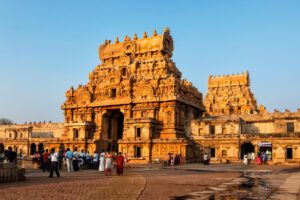
Now called the Brihadishwara temple, its original name was Rajarajesvaram, after Rajaraja Chola I. (iStock)
Now called the Brihadishwara temple, its original name was Rajarajesvaram, after Rajaraja Chola I who commissioned the construction of this colossal edifice.
The most eye-catching feature of this temple is the soaring vimanam or the superstructure above the main sanctum which houses a colossal stone Linga. This vimanam rises to a height of about 60.96 meters. The inscriptions of this temple, numbering more than a hundred, deserve special mention.
They are neatly etched on the walls of the temple, the majority of them being in the Tamil language and the ancient Tamil script. They mainly record the numerous donations made to the temple by Emperor Rajaraja, his sister Kundavai, his queens, his illustrious son Rajendra, and others, in the form of land, gold, jewels, etc., in great detail.
These epigraphs also reveal that this temple was a center of the performing arts with many musicians and dancers attached to it. These artists, who were greatly respected in society, sang and danced before the deity of this temple and were honoured by this king.
Two long streets with numerous houses were allocated only for the four hundred lady dancers attached to this temple! There are some inscriptions of later eras as well.
The Brihadishwara temple is known for the exquisite murals of the Chola times of the early 11th century AD adorning the walls of the dark circumambulatory passage around the main sanctum.
Unfortunately, these murals were painted over by the artists of the Nayak times of the 17th century AD. The Archaeological Survey of India is now involved in the painstaking work of exposing these rare Chola murals, after removing the Nayak paintings, but without damaging the latter.
Another noteworthy aspect of this temple is a row of sculptures of the karanas (dance movements) exactly as they have been described in the Natya Sastra, an important treatise on Indian dance.
However, this series is incomplete with only eighty-one of the hundred and eight karanas having been sculpted here.
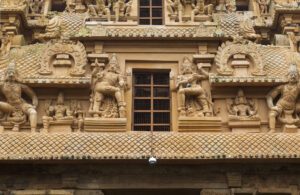
The Brihadishwara temple is known for the exquisite murals of the Chola times of the early 11th century AD. (iStock)
Each of these sculptures depicts Lord Siva as Nataraja (the Lord of Dance) with four arms in each of the poses – a unique feature not found in any other temple. The Chola epoch is well-known for its superb metal images of the Gods and Goddesses of the Hindu pantheon, especially Lord Nataraja, the favourite deity of this dynasty.
Rajaraja and his family donated a very large number of such metal images to this temple as recorded in the inscriptions.
Rajendra Chola I (1012-1044 AD), the worthy son and successor of Rajaraja Chola I, shifted his capital from Thanjavur to Gangaikondacholapuram where he constructed the gigantic temple to Lord Siva called Gangaikondacholisvaram. The vimanam of this temple, which resembles the one in Thanjavur, rises to a height of 160 feet and enshrines a Linga approximately 13 feet in height.
Even though it is a few meters shorter than the vimanam in Thanjavur, the one at Gangaikondacholapuram is as stately and has often been termed as the feminine counterpart of the Thanjavur vimanam. This temple has a mahamandapa in front of the central sanctum and the mukhamandapa. There is a gopuram in the east, of which only the base remains with the superstructure having collapsed.
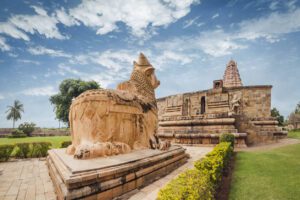
It is not known if the large Nandi is the original one when this temple was consecrated in the 11th century AD. (iStock)
It is not known if the large Nandi which is near this gopuram, and constructed of stones and stucco, is the original one enshrined when this temple was consecrated in the 11th century AD.
Some of the other structures found in this temple are the Simhakeni or well into which some of the waters of the Ganga brought by the army of Rajendra I are said to have been poured, the Mahishasuramardini shrine, the Southern Kailasa, a small shrine for Ganesha, a shrine for Goddess Brihannayaki, and the Chandikesvara shrine.
The sculptures of this temple are simply outstanding. Deserving of special mention are those of Chandesa Anugrahamurti and the one of Sarasvati opposite it. There is also a galaxy of images of Ganesa, Vishnu, Subrahmanya, Brahma, Nataraja, and many others.
There are also many pairs of dvarapalakas (gate guardians) in this temple, some gigantic. Noteworthy is the Solar altar or the Saurya Pitha which is like a full-blown lotus with Surya and the eight planets.
One of the outstanding specimens of the Chola style of temple architecture can be seen in the small town of Darasuram, very near the famous temple town of Kumbakonam. This temple, constructed during the reign of Rajaraja Chola II (1146-1173 AD), was originally named Rajarajeshwaram after this emperor but is now called the Airavateshwara temple. It is dedicated to Lord Shiva who was the family deity of the monarchs of the Chola lineage.
A touching story associated with this temple is about how the mighty monarch Rajaraja II authorised the construction of this great edifice to satisfy the wishes of a cowherd girl of Darasuram, who earlier had donated a stone to crown the apex of the colossal temple at Thanjavur and wanted a similar temple in her village in the future.
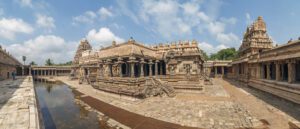
The Darasuram temple, like others of the time, became the centre of an entire township. (iStock)
The grand vimana (structure above the main sanctum-sanctorum), rising to a height of approximately 24 meters, is built completely of granite like most other structures in this temple. At quite a distance from the main sanctum is a gopura (entranceway to temples) in a very ruined condition today.
It must have once served as the main gateway to this temple, giving the visitor an idea of the colossal area this temple complex must have once covered.
Today, the entrance is via another gopura, in a fully preserved condition, closer to the main sanctum. There is a huge wall running around the four sides of this temple, on which are numerous stone images of Nandi, the sacred bull on which Lord Shiva rides.
Visitors to temples of South India always notice the fierce four-armed dvarapalakas or doorkeepers who guard the entrance to the shrines and there are many of these at the Darasuram temple too.
The most eye-catching feature of this temple is the pillared mandapa (pavilion) through which devotees have to pass to enter the main shrine. The entrance to this mandapa is constructed like a chariot, with wheels and dragged by horses and elephants.
The rims and spokes of the wheels bespeak the degree of skill the artisans of the 12th century possessed. On entering this mandapa, one can only gaze in awe at the innumerable sculptures, some very minute, covering every part of the pillars and even the ceiling.
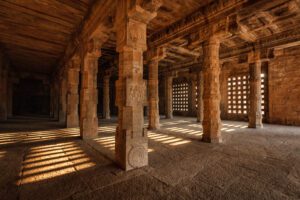
The most eye-catching feature of this temple is the pillared mandapa (pavilion). (iStock)
Square and rectangular panels with figures of dancers and musicians adorn the ceiling along with detailed decorative designs.
All the Chola monarchs were great patrons of the fine arts, and musicians and dancers attached to the temple performed here daily as this was a part of the ritualistic worship, and these sculptures highlight the then-existing tradition.
The Darasuram temple, like others of the time, became the centre of an entire township, sustaining and contributing to the society and economy.

May 01, 2024

Apr 28, 2024

Apr 26, 2024

Apr 25, 2024

Apr 24, 2024

Apr 19, 2024